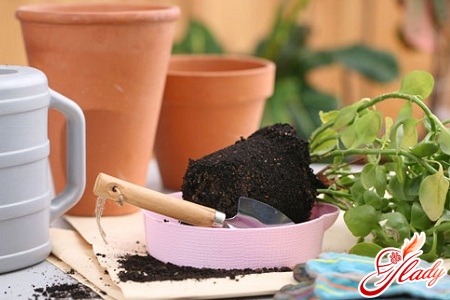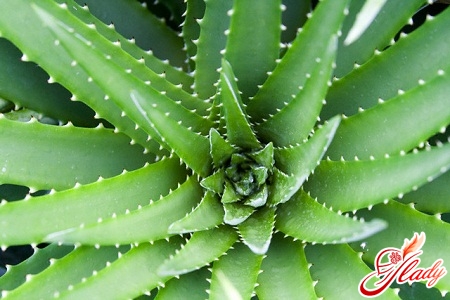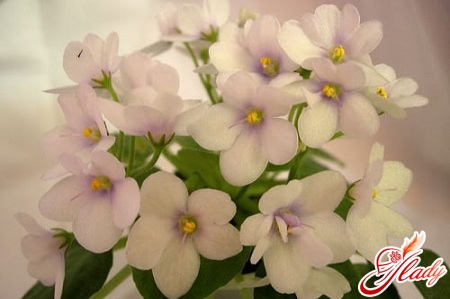 What kind of plants are not grown at home?Florists: some are captivated by the exotic beauty of orchids, others like to grow cacti. But there is not a single lover of house plants who would not like the indoor violet, the care of which will not be difficult even for a novice florist.
What kind of plants are not grown at home?Florists: some are captivated by the exotic beauty of orchids, others like to grow cacti. But there is not a single lover of house plants who would not like the indoor violet, the care of which will not be difficult even for a novice florist.
We buy a violet
Saintpaulia, or African violet, isprima of indoor floriculture. The endless variety of its species and luxurious palette of colors attracts the attention of both collectors and lovers of indoor plants. Even if you go to a flower shop or to a flower insert just like that, out of idle curiosity, and see a violet, you most likely will not be able to resist buying this beauty. If this happens, then when buying a plant, first of all, you should pay attention to its leaves. If you find a too tight growth point or some suspicious spots on them, then this plant is probably affected by some disease. Not only a beginner will have a hard time going out and growing such a plant, but even a specialist. Therefore, you need to choose a plant whose leaves have a bright green color without the slightest signs of damage by diseases and pests. For reproduction, you should take a leaf from the lower second row. Cuttings from the lower row also give babies, but they are usually more exhausted, so their offspring will be obviously weaker. Be sure to ask the seller what variety the plant is, so you don’t have to figure it out by eye later. When choosing a cutting, it is very important that the leaves are not elongated. This indicates that the plant grew in conditions of insufficient light. When buying a plant, you should make sure that there are no spots on the leaves. The growth point should look healthy, with no signs of decay. The name of the variety should be indicated on the pot, and it would be nice if the planting date was also indicated. For transportation, it is convenient to use cardboard boxes, plastic containers or other containers that will protect the cutting from damage. If there is no such box, then you can inflate a plastic bag and tie it tightly. In this case, the cutting will also not be damaged during transportation. Overcooling of the root system can lead to the death of the plant, so if you agree in advance to buy a violet, ask the seller not to water it three or four days before purchase. To transport the plant in winter, it must be packed in several layers of newspaper, and then placed in a plastic bag. You can wrap the plant in a downy shawl or put it on a heating pad. If during transportation, when you unpack the purchase at home, it turns out that some leaves are broken, they need to be carefully removed from the outlet. These leaves can be put in water and in a few months, when they become starters, they can be planted in the ground. Violets are light-loving plants, but they do not tolerate direct sunlight. The ideal place for growing them will be windows facing east or west. On windows facing south, they should be shaded. The best temperature for keeping them will be 20-24 ° C. If you have a lot of violets, then it is better to equip a shelf with lighting for them. This will allow you to place many plants in a small area, optimally providing them with light.
Reproduction of violets by cuttings
Each florist chooses a reliable one for himselfand a convenient way to root a violet cutting. At home, the best way is to root in boiled water. If desired, you can buy substrate components for these purposes - agroperlite or vermiculite. A good way is to root a violet cutting in sphagnum moss, which is finely chopped for this purpose. Recently, a method of rooting cuttings in peat-humus tablets has become widespread. In them, the risk of rotting of the cutting is minimized. But no matter how you root the cutting, there is a general rule - do not leave a long petiole. If the length of the petiole does not exceed four centimeters, then the babies will appear faster and will be larger. It is good to make a cut on the cutting with a scalpel. When rooting the cutting, it is necessary to ensure a room temperature of 20-24 ° C and high humidity. To do this, you can place the cuttings that are planted for rooting under a glass jar or a plastic bag. The babies appear in a month and a half. When the babies grow up and get stronger, they should be carefully separated from the leaf, trying as much as possible not to injure the roots of the babies. The baby should be planted in a separate pot, the diameter of which should not exceed six centimeters. If the leaf is strong, then it can be left to re-root. When replanting the baby, drainage should be placed on the bottom of the pot, which can be pieces of foam plastic, sphagnum moss or small expanded clay. The soil for the babies should be nutritious and loose, for which you can add 20% vermiculite and 20% perlite to the substrate. You can also add finely chopped sphagnum moss. It is also put up to 20% of the total volume. After the babies are planted, they need to be placed in a mini-greenhouse for two or three weeks so that they can adapt. As we have already said, a glass jar or a plastic bag placed on a pot can serve as a mini-greenhouse. The greenhouse should be placed on a light, but preferably not southern windowsill. On the southern windowsill, violets should be shaded so that the leaves do not get burned. In winter, the window should be closed tightly, and there should be no drafts from the cracks, because violets are very sensitive to hypothermia of the root system. Grown-up babies need to be gradually accustomed to normal room conditions. To do this, ventilate the greenhouse first for 10-15 minutes, and then increase the time.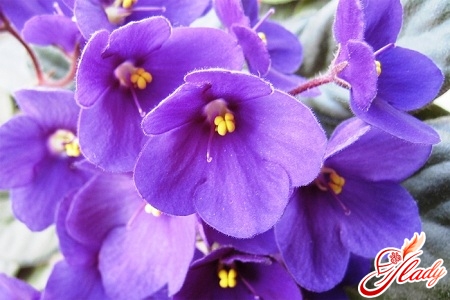
Reproduction of violets by stepsons
Violets can be propagated not only by leavescuttings, but also stepsons. For successful rooting, a stepson must have three or four leaves. The stepson is separated from the rosette with an awl or a sharp scalpel. When the stepson is separated from the main rosette, you should try not to injure its leaf cuttings. Stepsons are rooted in a pot with substrate or in peat-humus tablets. For faster rooting and better adaptation, the transplanted stepson should be kept in a greenhouse. As a rule, chimeras and fantasy varieties are propagated in this way.
Care of the socket
Caring for violets at home is notwill give you much trouble. But during the period of active growth, young rosettes need balanced soil and good lighting. The soil should not be too heavy and greasy, but sufficiently nutritious. In order for the rosette to form evenly and symmetrically, it should be turned 45° every three to four days. If the cuttings and leaves of the rosette are strongly raised upwards, then your plant does not have enough light, and it should be provided with additional illumination.
Selection of dishes
When choosing a pot for a violet, you should consider,that its size is very important. The diameter of the pot for young rosettes and babies should be 5-6 centimeters, and for adult rosettes it should not exceed 10-12 centimeters. Ideally, for an adult rosette, the diameter of the pot should be three times smaller than the rosette itself. Both ceramic and plastic pots are suitable for violets. With today's choice of plastic containers, flower growers choose plastic pots for growing violets, as they are more convenient and cheaper. To prevent water from stagnating in the pot, it is necessary to make drainage in it, for which you can use sphagnum moss, expanded clay or pieces of foam. The drainage should fill at least a third of the pot.
Top dressing and watering
The violet should be watered with room temperature water.temperature or a few degrees higher. It is better to let tap water settle or filter for irrigation. You can water from above or by pouring water into the tray. When watering, water should not get into the growth point or on the leaves. The water remaining in the tray after watering must be drained after 10-15 minutes. The soil in the pot should not be wet, but damp, otherwise the root system may begin to rot and the violet will die. The frequency of watering depends on the air temperature in the room and the composition of the soil. As a rule, violets need to be watered once or twice a week. You cannot water violets with distilled water, because it actively adsorbs salts. With regular use of distilled water for irrigation, all salts are washed out of the soil: not only harmful, but also useful. Due to the lack of nutrients, the violet begins to grow worse and stops blooming. When feeding, the earthen lump should not be overdried. In principle, the substrate contains all the nutrients necessary for the normal development of the violet, so it does not need special feeding. In order to replenish the supply of nutrients, it is enough to replant the violet once every 9-12 months. If you feel that your violet is depleted, you can feed it. For this, both liquid and granular fertilizers are used. When buying fertilizers, be sure to read the instructions. If the composition is not indicated on the label, then it is better not to buy such fertilizer. If you are not buying a specialized fertilizer for violets, then it should be diluted in half. Top dressing can be done once every three to four weeks. The nitrogen content in the fertilizer for young rosettes should be greater than the content of phosphorus and potassium. For active budding and lush abundant flowering, the fertilizer should contain more phosphorus. Fertilizers "Fialochka" and "Phosphatnoe" are suitable for this. Excess nutrients can do less good than harm. Therefore, violets should not be overfed with fertilizers. It is necessary to find out before feeding what caused the unhealthy appearance of the violet. If it was a consequence of a violation of agricultural technology or was caused by some disease, then feeding can only harm.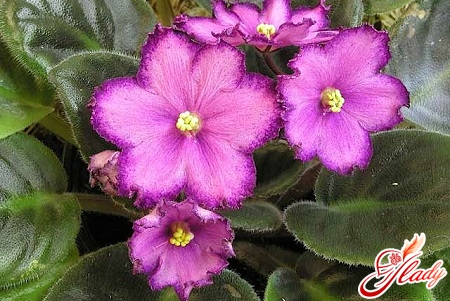
Care for an adult rosette
Old leaves often lose color andbegin to spoil the general appearance of the plant, so they need to be removed. You can even remove the entire bottom row, and cover the rosette itself with moss from below or add soil to the pot. If a trunk forms on the rosette, then the violet needs to be replanted, slightly deepening it to the bottom row of leaves. As we have already said, adult rosettes need to be replanted every nine to twelve months, because the substrate is depleted of nutrients. In this case, the diameter of the pot should be selected correctly - in a ratio of 1: 3 with the diameter of the rosette. In order for the violet to always look beautiful and not suffer from dust, its leaves should be washed sometimes. It is best to do this once or twice a month in the cold season, and every week in the warm season. The rosette is washed under a weak stream of water at room temperature. After this, the plant is placed in a warm place to dry. If it is placed in a cool place after washing, the leaves may become covered with light spots. If the rosette has stopped growing, then you need to check the soil - has it compacted? If the soil is too dense, the violets should be replanted in loose, light soil. If the soil is fine, the violet may not have enough nutrients. Then it should be fed a little. Another possible reason for the rosette to stop growing and to wither is poor root system development or even its rotting. If the violet leaves are small, wilted, dull, then you need to cut the rosette at the base, remove the rotten parts, and then re-root it in water. If the violet forms a lot of leaves and practically no flower stalks, then most likely the plant is overfed with nitrogen fertilizers. You should wait 4-6 weeks and feed it with phosphorus-containing fertilizers. If too many leaves have formed on the rosette, you can remove a couple of the lower tiers of leaves, not forgetting to sprinkle the wounds with charcoal powder. If the flower stalks have become short, the flowers have started to shrink, and the violet leaves have become brownish, then the plant suffers from excess light and needs to be shaded. Then the newly emerging leaves will eventually acquire a normal color. Brown leaves can be gradually removed, since they will not restore their color. It is better not to transplant flowering rosettes. If there is no other way out, then the rosette is transferred to a more spacious pot, rather than transplanted. After this, you should add soil along the edges and tear off the flower stalks so that the plant does not become depleted. If you follow all the above rules, then violets and caring for them will bring you true pleasure. Blooming Saintpaulias will delight you with luxurious caps of delicate flowers of all sorts of shades - from white and pink to lilac and dark purple. We recommend reading:






